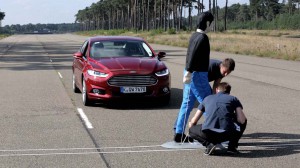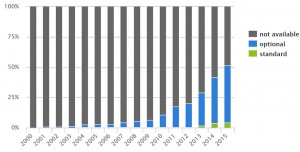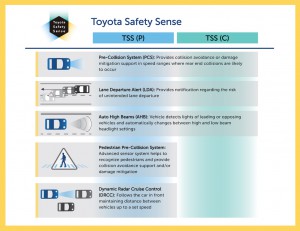Once available only on a handful of the most expensive luxury models, a growing number of vehicles, including mainstream and even economy models, now offer forward crash warning systems. That means better protection for passengers and improved safety ratings for manufacturers.
For the first time ever, more than half of all new cars, trucks and crossovers offer standard or optional forward crash warning systems, according to a new report from the Insurance Institute for Highway Safety. And a quarter of all new vehicles take things a step further with warning systems that can automatically apply the brakes, if necessary.
There’s growing evidence the technology is helping reduce highway crashes, injuries, and possibly fatalities.
As part of its ongoing series of tests, the IIHS is awarding 19 new models its superior or advanced ratings due to the addition of forward crash warning technology.
“Most motorists won’t be riding in driverless cars anytime soon,” said David Zuby, the IIHS’s executive vice president and chief research officer. “In the shorter term, automatic braking is an accessible technology that’s within reach for many drivers.”
(Consumers are growing increasingly frustrated by the surge in safety recalls. Click Here for the story.)
First introduced on vehicles like the Mercedes-Benz S-Class, forward collision warning systems have rapidly migrated to more mainstream segments of the market, even coming on such low-end products as the $18,990 Subaru Impreza. A number of manufacturers have begun wrapping version of the technology into affordable packages, such as the new Toyota Safety Sense, available on a wide range of models for as little as $300.
Seven of the 19 vehicles to be tested by the IIHS fall into the moderately priced category. The rest are luxury models.
(Automakers rush new affordable crash avoidance technologies to market. Click Here for more.)
The most basic systems flash or sound a warning when a collision seems imminent. More advance versions can automatically apply the brakes if a driver doesn’t respond quickly enough, helping prevent a crash, or at least reduce its severity.
“We’ve seen an uptick in the number of luxury and mainstream models with available autobrake,” noted IIHS exec Zuby. “That’s a welcome sign for highway safety and helps pave the way for the eventual deployment of fully autonomous vehicles.”
Some form of forward collision avoidance is now necessary to earn high marks from the IIHS, such as its overall Top Safety Pick Plus rating.
The trade organization has also begun comparing the actual collision avoidance systems to ensure they’re effective. As a result, 19 models offering the technology have earned top ranks from the organization in its latest round of testing.
Fourteen were rated Superior, a list including: the 2016 Acura ILX, MDX, RDX and RLX; 2016 BMW X3; 2015 Chrysler 300 and its twin, the 2015 Dodge Charger; 2015 Mercedes-Benz C-Class (both Collision Prevention Assist Plus and Pre-Safe Brake equipped versions), CLA (both Collision Prevention Assist Plus and Distronic Plus equipped versions) and E-Class; and the 2016 Mazda 6 and CX-5.
The basic BMW X3 uses a camera-based forward collision warning system. But, when upgraded with a camera-and-radar system, IIHS gives it an Advanced rating. Four other models earn that top mark: the 2016 Volkswagen Golf, Golf SportWagen, Jetta and 2015 Volkswagen Touareg.
Experts consider systems combining radar and camera technologies to be more effective than systems that just use one of those sensing methods. They can more precisely track closing speeds and they can operate at greater distances.
Industry experts are still studying the effect forward collision warning has had on highway fatalities, which often involve higher speeds, but officials with the IIHS have found a clear correlation in terms of reduced injuries in lower-speed crashes and in routine fender-bender type collisions that can occur when drivers become distracted in heavy traffic.
A new study released this week by J.D. Power and Associates found that many U.S. motorists don’t use — or like — the various technologies being loaded onto the latest vehicles. But the study distinguished between infotainment-style features and safety technology, finding widespread support for advanced safety systems like blind spot detection and forward collision warning.
(Click Here for more on the new JD Power auto technology study.)




Unfortunately consumers will be forced to pay for more technology that a lot of us will never use. As far as the “evidence” is concerned there is growing evidence that accidents and injuries have increased despite the improved safety features on newer vehicles. That is unfortunately the result of inattentive or distracted driving.